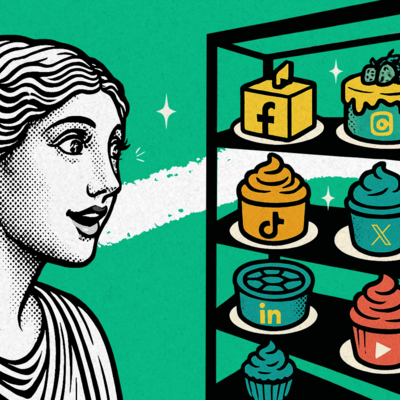
I’ll help get your internal AI initiatives unstuck.
Hey! Dan here.
Every company knows they need to integrate AI. But most internal initiatives get stuck at some phase of the process. Whether it’s research, implementation, or training, it can be hard to get new technology over the finish line if no one is directly responsible.
I’ve been consulting with a few select mid-to-large-sized companies to help them maximize AI’s ROI and bring their projects over the finish line.
Does that sound interesting?
Was this newsletter forwarded to you? Sign up to get it in your inbox.
Reading AI writing today is sort of like playing Guitar Hero and pretending you’re in a real-life band, or like trying to hold an intimate conversation with a poster:
These feelings won’t last. They will likely be replaced with a rich sense of connection and meaning—feelings that will be as intimate and enveloping as those we have in interactions with our phones, our novels, and our films. It won’t be an exact substitute for human connection but will satisfy some of our needs.
To understand how and why I think this will happen, we have to review some history—and some psychology.
How our attitudes toward new technology change
New technology always seems impersonal. It always feels like a poor replacement for whatever came before it. With time, certain technologies manage to escape this nascent state and become part of the fabric of daily life, and therefore imbued with rich layers of meaning and depth. Mostly, this is generational.
A simple example: My parents generally prefer a phone call to a text. They feel that chatting with their thumbs is impersonal. On the other hand, texting creates a real sense of connection for people of my generation. I love the passive presence that a constant stream of back-and-forth texts evokes.
I’ve heard from people younger than me that they feel differently. They prefer sending Snaps (written or visual ephemeral messages) to their friends. That feels vapid to me. But I don’t have any doubt that I’d be sending them, too, if Snap had been around when I was growing up.
This pattern of changing attitudes has been going forever, though. In 1929, people complained about how the radio is impersonal and kills human connections:
“All the modern host needs is his sixteen-tube Super-sophistication [radio] and a ration of gin. The guests sit around the radio and sip watered gin and listen to so-called music interspersed with long lists of the bargains to be had at Whosit’s Department Store by those who get down early in the morning. If they are feeling particularly loquacious, they nod to each other. Thus dies the art of conversation. Thus rises the wonder of the century⎯ Radio!” [Emphasis added]
Typewriters faced the same suspicion when they were first introduced in the late 1800s. At the time, people associated typeset lettering with advertising, so getting a typewritten letter was impersonal, confusing, and even insulting. Today, we have no sense that messages written in type are too impersonal. That’s how the vast majority of our personal communication occurs.
AI is the latest example. Where phones allowed communication between people across distances and texts between two people at different times, AI allows net-new communication that is unshackled from personal attention. But its adoption will follow a similar pattern: distrust, at first, and eventual integration into our culture.
How do we account for these changing attitudes?
Why our attitudes toward technology change
The Only Subscription
You Need to
Stay at the
Edge of AI
The essential toolkit for those shaping the future
"This might be the best value you
can get from an AI subscription."
- Jay S.
Join 100,000+ leaders, builders, and innovators

Email address
Already have an account? Sign in
What is included in a subscription?
Daily insights from AI pioneers + early access to powerful AI tools










Comments
Don't have an account? Sign up!
👍🏽
Great post, Dan. I've been having similar thoughts about this, especially the fact that "Human-made" writing may actually increase in value as AI-generated content proliferates further.
I welcome the idea of having two "separate tracks" - one for AI-based entertainment (whether it's writing, movies, music, and more) that we acknowledge as such, and another one for when we're seeking a human connection.